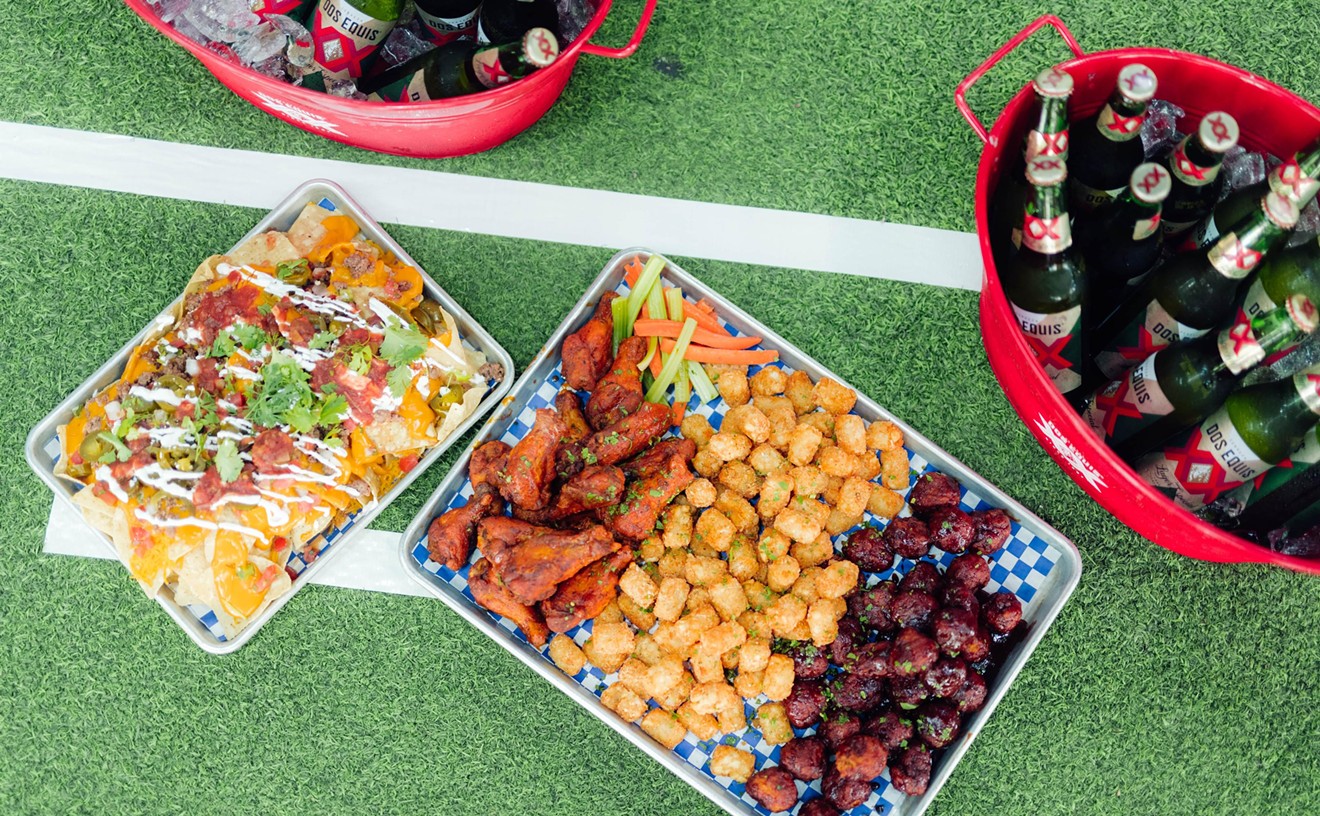Even as immigrants arrived in the early years, their cuisines were bastardized to please soft U.S. palates. Thus the torpid chop suey, spaghetti and meatballs, or Mexi-bake casseroles made with hamburger, Fritos, Velveeta and taco sauce -- dishes that would have been tarred, feathered and ridden out on a rail in their countries of so-called origin.
Our kitchens could benefit from a little gourmet guerilla shake-up. An invasion of foreign chefs bearing exotic spices, unique herbs, romantic fruits and glamorous sauces could put passion into our everyday pot roast.
All we have to do is look to faraway lands like Peru to see what fine things the convergence of cultures has done to a nation's cooking. And now, to taste the magic for ourselves, all we have to do is hop in our cars and motor out to the southwest corner of Warner and Dobson, home to the new Peruvian restaurant called, appropriately enough, Peruanitos. This little place is an outright gem, combining all the best of friendly service, upbeat atmosphere, low prices and fascinating multi-fusion South American food in one colorful package.
Derived from the Incan empire, Peruvian cuisine is a melting pot of Spanish, Asian, European, African and ancient American influences. From this comes a tapestry woven with marvelous fruits, roots, potatoes, vegetables, nuts, cereals, seeds, grains and low-fat meats like llama and vicuña. While we won't find any alpaca entrees at Perunanitos, we do indulge in the exhilarating flavors, colors, aromas, textures and fragrances that comprise the luscious Latin American dining experience.
Owned by Amanda Watson de Arriola, Peruanitos opened just two months ago under the direction of Amanda's husband, general manager Mario. The de Arriola family -- relocated from Peru -- runs all aspects of the operation, including crafting the authentic Latin American dishes that are served. And while the nondescript strip mall on the edge of Chandler is easy to miss, it's likely this place won't be a secret for long. Folks in search of authentic ethnic cuisines already know the area well -- the restaurant is next door to one of the Valley's best dim sum restaurants, C-Fu Gourmet, and kitty-corner from a popular Oriental market, Lee Lee.
The de Arriolas' timing couldn't be better, either. From Manhattan to Miami, Peruvian cuisine is emerging as the latest Latin darling of international dining aficionados. Recently, and for the first time ever, the distinctive dishes were showcased at New York's French Culinary Institute, at a three-week event at the United Nations dining room, and in the inaugural Peruvian Gastronomy Festival in south Florida.
Such a warm, welcoming ambiance is another sign of success to come. Mario greets us at the door, and leads us to our choice of white plastic-topped tables set among bright yellow, red and white walls, with tiles inset like a confetti mosaic. Art is worth admiring, including pictures of the Peruvian countryside, a large breakfront packed with Andean figurines, woolen rugs hung on walls, and a pair of giant, stuffed toy llamas. And while a big-screen TV is out of place, it's showing an international soccer match, and the sound thankfully is turned off. Smooth Latin American acoustics are piped in at lunch, and the vigorous live guitar and keyboard tunes at dinner lift spirits -- Mario and crew play a "musica negra" Mayan-Creole style of music from the heart of Baranco.
Peru is about potatoes, and Peruanitos uses them in good form. Although we don't get the rainbow varieties found in the native land -- purple, red, rose, transparent, black -- the simple white spud is elevated in dishes such as a papas a la huancaina appetizer. This unassuming-looking dish packs a wallop, layering thick slabs of boiled potato and onion strips with a neon-yellow, creamy cheese sauce topped with sliced hard-boiled egg and black olives. The color comes from palillo, a highly aromatic herb found in the highland city of Huancayo; the slow-burning heat comes from the fiery rocoto or aji amarillo chile sauce dashed in. I couldn't say if the sauce uses traditional llama-milk cheese, but I know it's delicious -- I use the dinner serving of soft French bread to sop every last drop.
The starter is similar to a luncheon entree of papa a la diabla, which, despite its devilish name, gains heat only with generous splashes of the chilled Rocoto Hot Pepper Sauce served alongside (it's a rain-forest product made with chile manzano, and it's delightful). Here, the potato slices are topped with white onion, hard-boiled egg and a mild, chewy, ricotta-like cheese.
A papas rellena appetizer, meanwhile, is pure Peruvian comfort food, bringing an oversized cake of mashed potatoes stuffed with spicy ground beef, sweet raisins and egg, fried golden and topped with red onion and black olives. A side makes it all the more interesting; it's ensalada rusa, a Russian inspired salad of peas plus finely diced red pepper and beets in a soothing mayo sauce.
In another spin on spuds, causa rellena de atun packs mashed-potato squares with fragrant Peruvian spices and wonderfully vinegary flaked white tuna. This is perfect summertime snacking, served cold, flecked with parsley, crowned with hard-boiled egg and lounging on a puddle of what tastes like a creamy onion-pepper sauce. Add an ice-cold bottle of Cristal Peruvian beer, and I'm setting up camp here until it cools down in October.
Food historians have called Peruvian cuisine the most sophisticated food in Latin America, and high style shows up in the rich chupe de camarones, a savory soup brimming with sweet shrimp, potatoes, rice, peas, cheese, poached eggs and a touch of chile. This huge bowl of silky, pale-pink chowder would be at home on any fine European menu, intriguing as it is with its complex, layered notes.
An Asian touch appears in another dynamic dish -- ceviche. A mixed version is marvelous, tumbling lots of fresh raw fish, crab, calamari, shrimp and octopus to "cook" in a tart marinade of lime juice. In traditional fashion, the ceviche is served alongside red onions, lettuce leaf, sweet potatoes and sugary Peruvian corn on the cob. The only way this dish could be better is if included cancha, crunchy roasted corn kernels that go brilliantly with the soft seafood.
The same swimmers -- minus the crab -- show up in jalea, a generous toss of seasoned, breaded and fresh fried octopus, squid, shrimp and fish. Crisp battered and moist, the lemony bites are complex with a salsa of red onion, corn and lime plus an eggy, herbed dipping sauce.
Peruanitos considers its lomo saltado de carne its house favorite, yet while the Chinese-inspired dish is certainly good, it pales under the vibrancy of other dishes served here. Essentially, it's little more than a cheerful sauté of tomato, red onion, potato and steak strips alongside white rice and excellent French fries. I like to spunk it up with swallows of Inca Kola, a sweet soft drink with a flavor that reminds me of Juicyfruit gum.
I'm much more taken with carapulera, a classic dish that defines the Incan concept of artisanal cooking. This pork in peanut sauce is painstaking to prepare, given its base of papseca, potatoes that are mashed and freeze-dried in a 2,500 year-old process. The resulting tubers are feathery light, soaking up the juices of large chunks of pork and swelling with the velvety, mildly spiced, orange-colored sauce nuanced with nutty tones -- toe-curling inspired. Aji de gallina is equally luxurious, blending mounds of shredded chicken breast in a sprightly, satiny red chile sauce with white rice and hard-boiled egg.
Still, the star dish here is a breathtaking adobo de chancho, a succulent concoction of marinated, slow-cooked pork with an electric, spicy undercut of serious chile heat. It's moist, meaty, and cools down a touch with fluffy rice and chilled sweet potatoes. Try it with a glass of chicha morada, a traditional, intense punch brewed from purple corn and flavored with cinnamon.
A few dishes aren't quite as thrilling. The menu warns us that that "seco" in seco de cabrito means dry. And the slow-simmered lamb chunks are just that. A marinade of orange juice, wine and vinegar lends a pleasingly sweet and spicy edge, and the meat revives a bit when sipped with a full-bodied Peruvian red wine. And perhaps it's a poor day for the sandwich de pavo, known in Lima as "the monster." The trouble is in the turkey -- the roasted, craved bird tastes gamy, even under an assertive dressing of sweet, pink, mustardy aioli.
Peruantios' cultural tour winds up with a nod to Africa in picarones, anise-sweetened, deep-fried pastries made from a pumpkin dough. Then, we're back to Spain with helado, a big parfait glass of deep-orange ice cream made from lucuma, a grainy, coffee-flavored coastal fruit. Startling flavors for first-timers, yes, but quickly compelling.
It's no wonder the American population has the highest obesity rate in the world. We've been raised in fat, happy security, with no threat of invasion to mess up our cozy backyard barbecues -- so bring on another two-pound steak. That's a good thing. And as long as we've got restaurants like Peruanitos to deliver the spoils of multicultural cuisine right to our doorsteps, that's even better.










